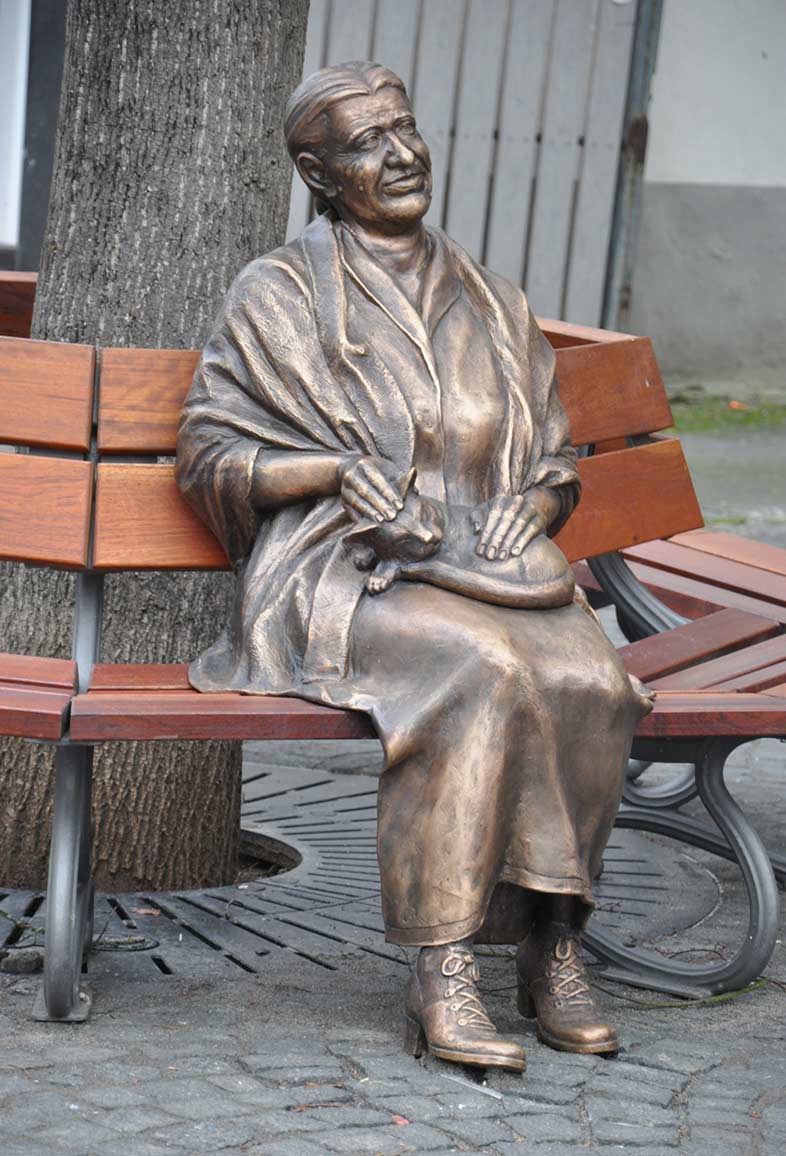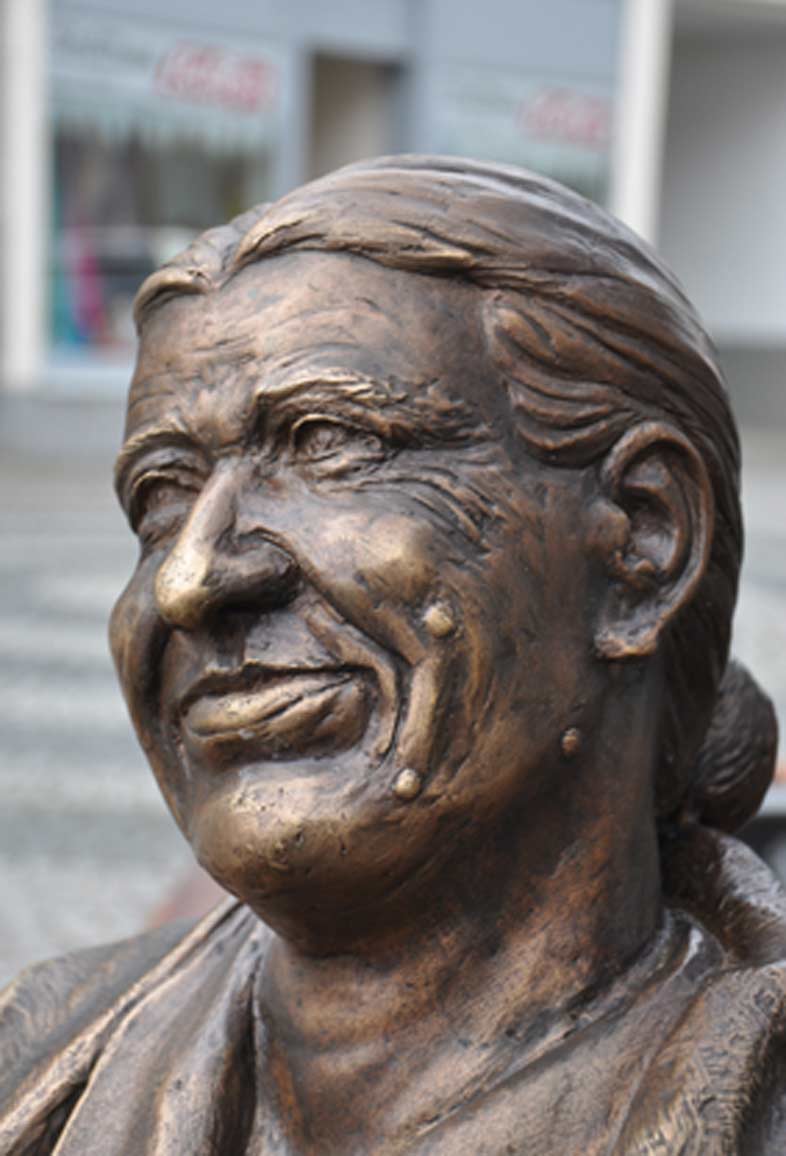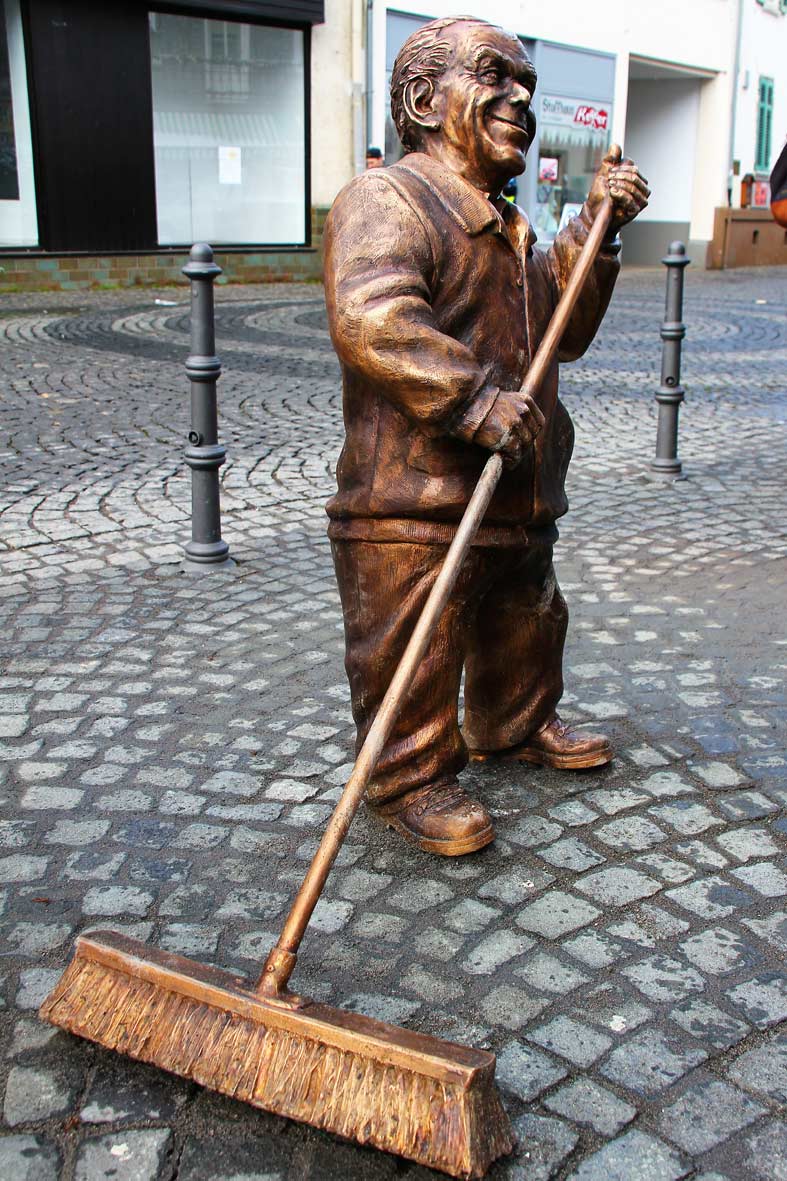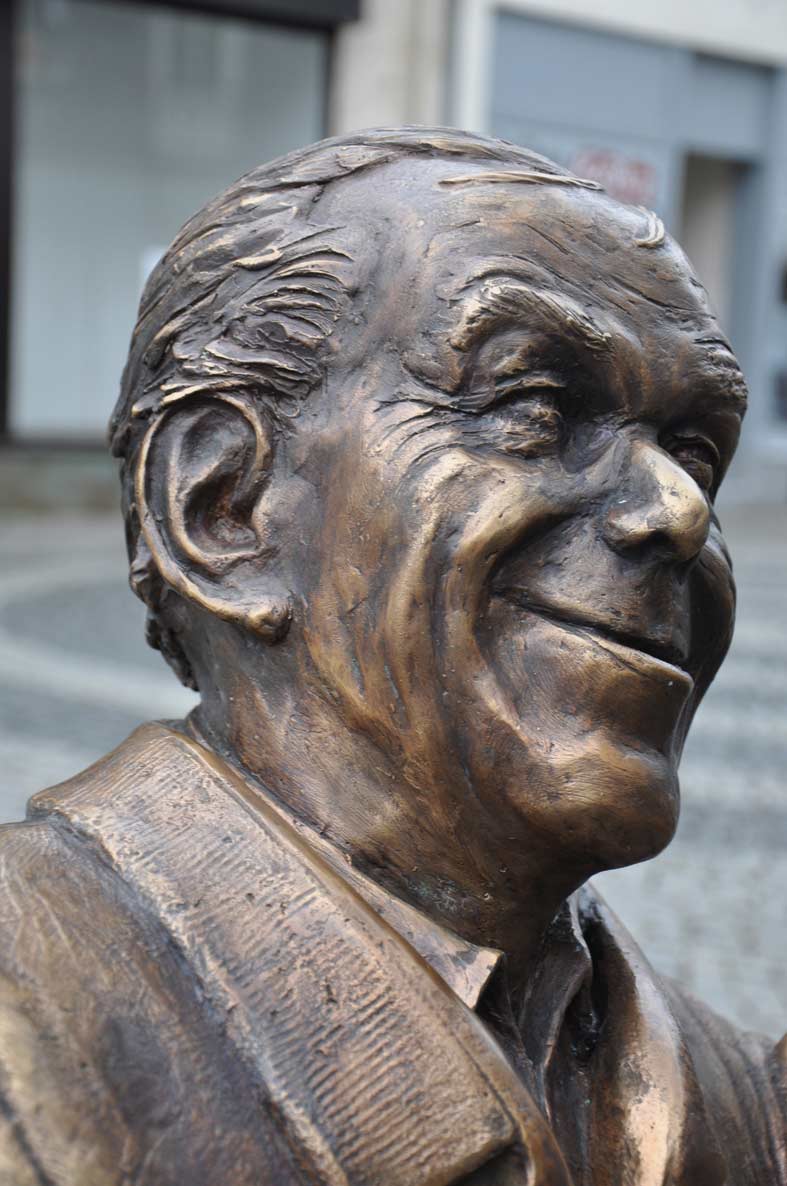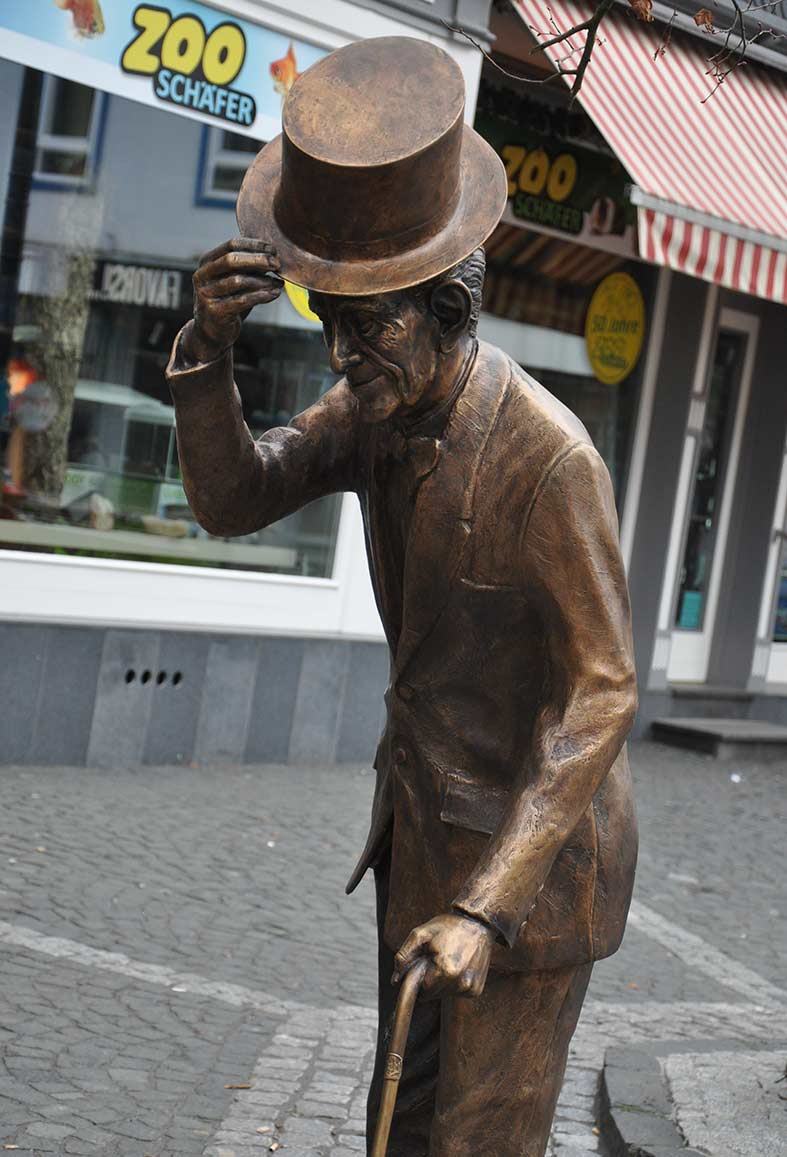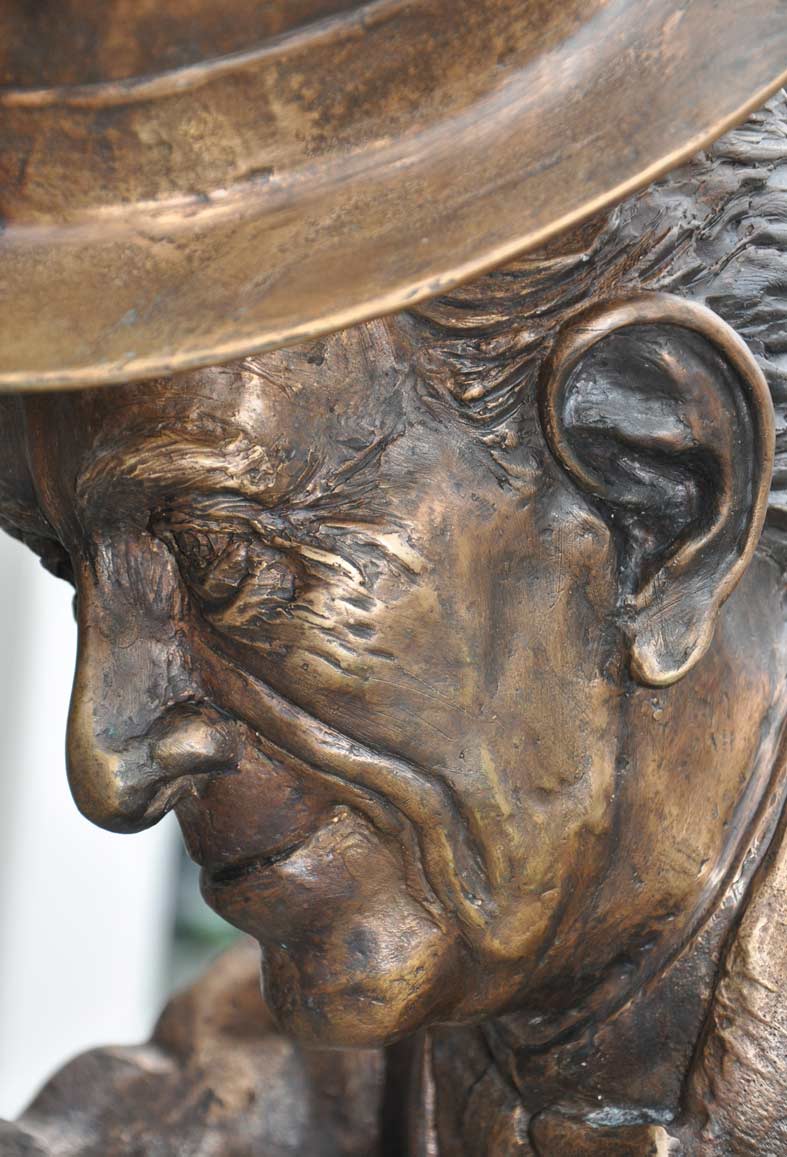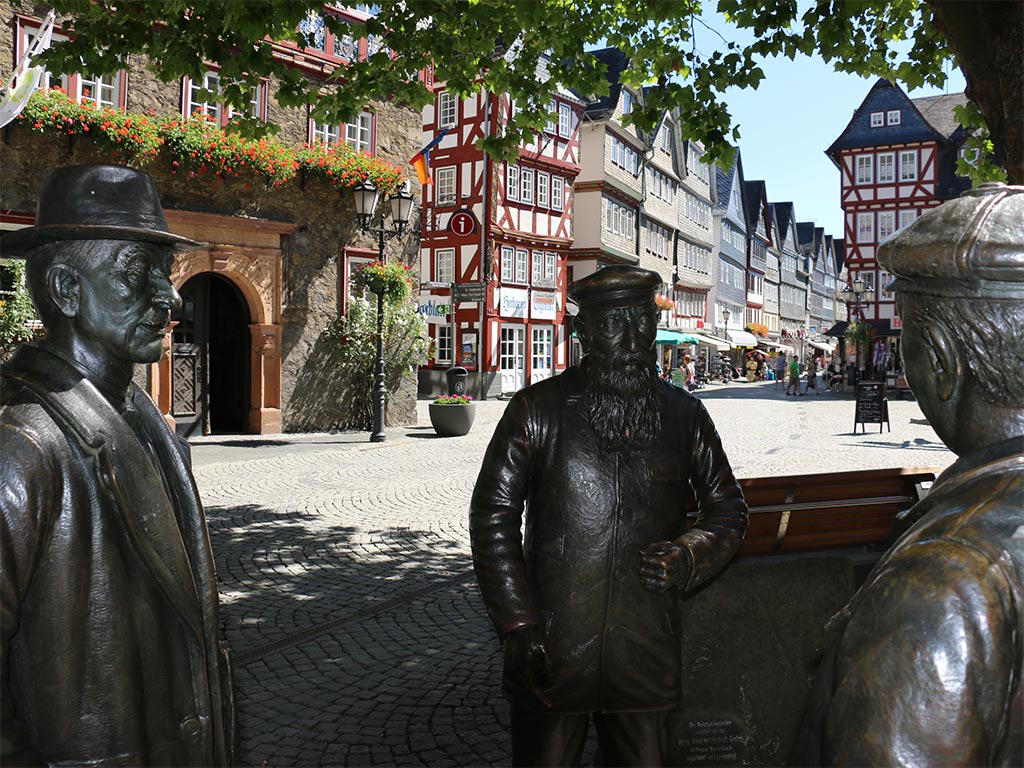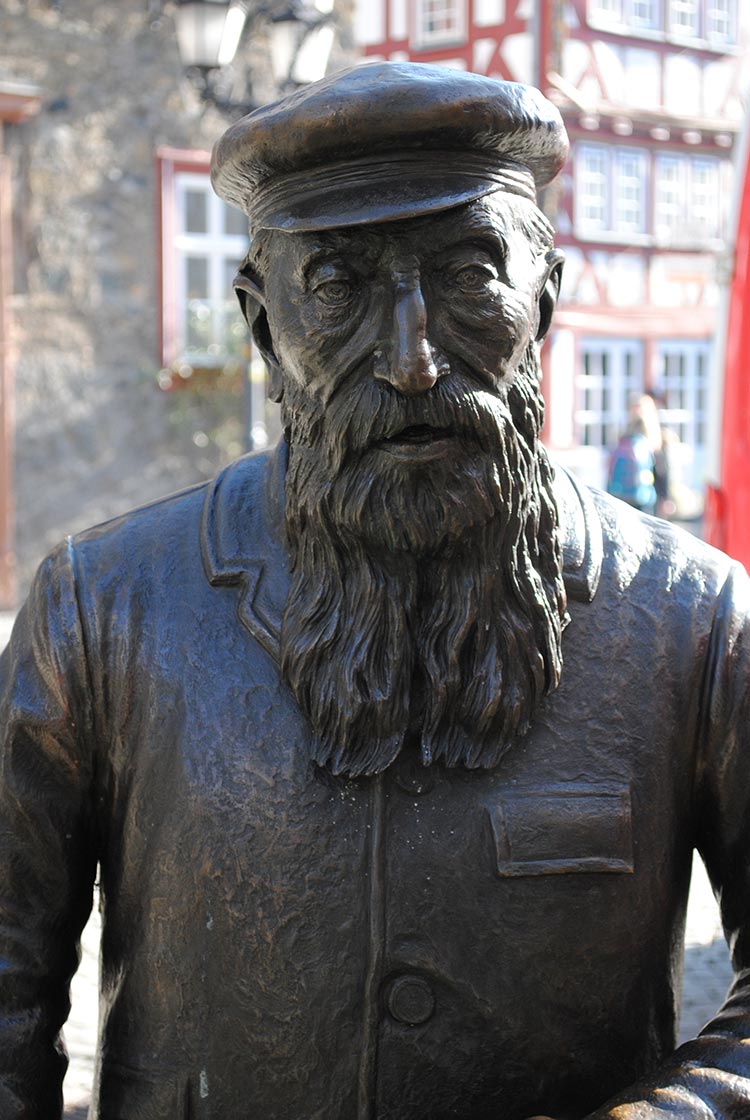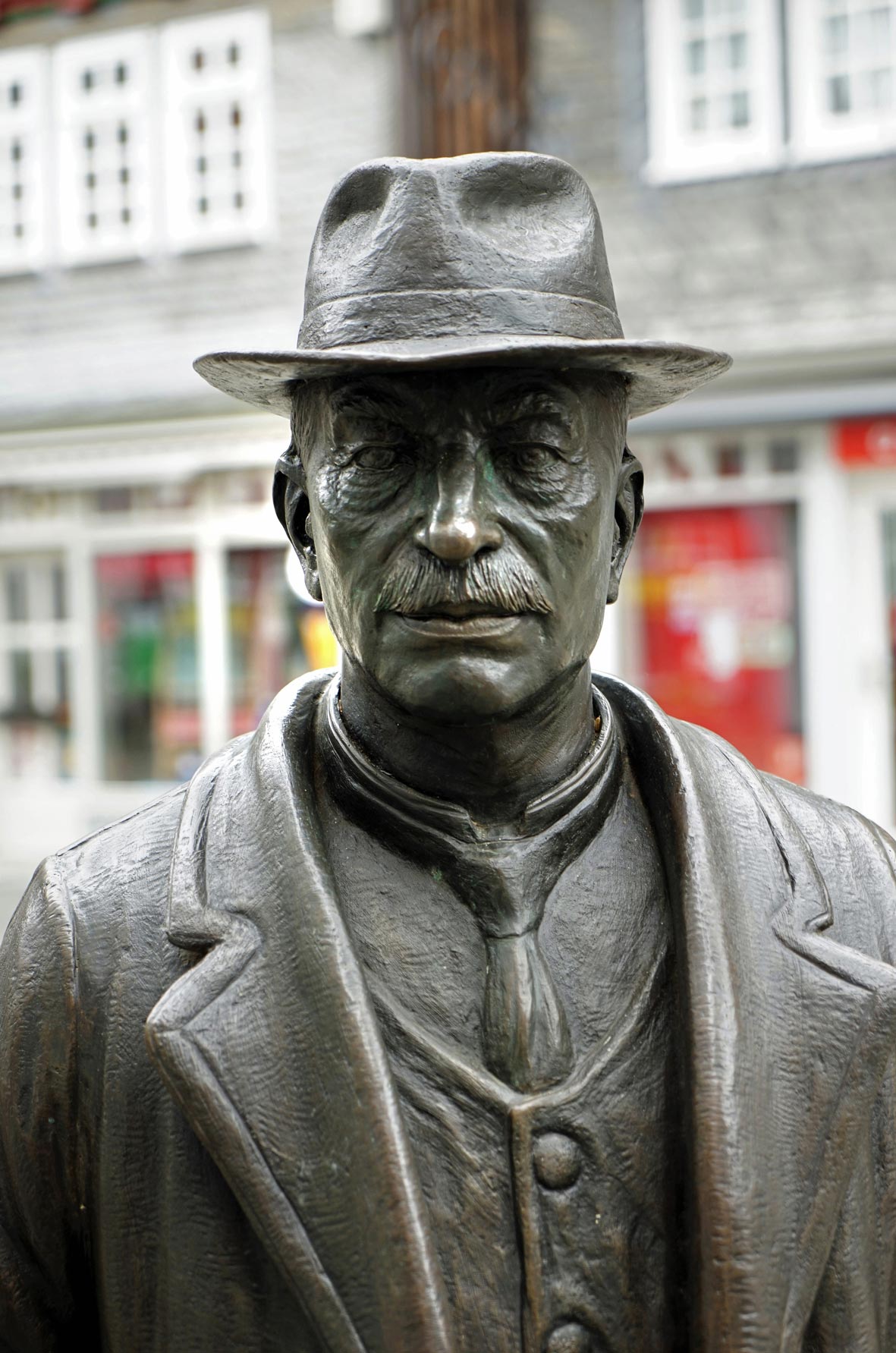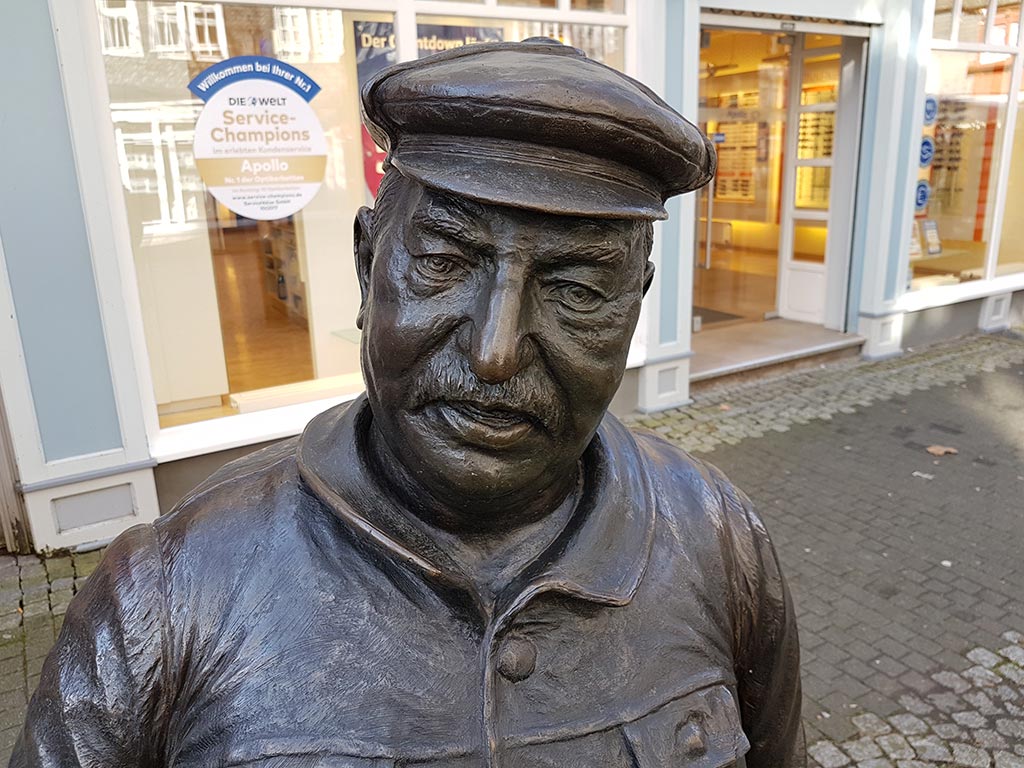Stay & Enjoy
Free time on your hands – things to do in Herborn
New statues showing Herborn originals (2017)
They are cast in bronze. With kitty, broom, and top hat: "’s Heinzche" Heinz Friese, Ernst de la Motte, and "Katzemarie" Maria Cyriax. Together, these three Herborn originals are forming our latest monument located at "Platz an der Linde".
"Katzemarie" (1907-1979)
The life of Maria Cyriax (maiden name Ufer, dubbed "Katzemarie", may, at best, be recounted with breaks and gaps. Hardly any written documents exist in relation to her life. The rare facts former town archivist, Rüdiger Störkel, was able to compile, he unearthed from old chronicles or ancient Herborn address books.
Maria Ufer, born 1907 in her father‘s official residence near the "Herborner Pumpenfabrik" (a company manufacturing all sorts of pumps), has been living in the old town most of her life under the address "auf der Mühlbach 16". It is believed that she moved to neighboring "Chaldäergasse" during the 1960ies.
But "auf der Mühlbach" was where she felt at home, there she entertained her "network" according to Störkel who depicts an image of those days long gone by: "Those who were familiar with the living conditions in the "Mühlbach/Chaldäergasse" neighborhood in the 1950ies before the large-scale restoration of the old town was launched, knows exactly how close-knit people in this community were back in the day."
The windows of the houses were almost always open and people living in the old town talked to each other across the streets. "Herborn long-distance calls without the phones", as Störkel puts it. These networks had grown and prospered over many years, only to be disrupted as a consequence of the restoration projects that now began to shape the face of the old town in Herborn. Many people were moved to modern social dwellings located on the outskirts of town while their old houses were torn down, including the house of Maria Cyriax.
"Katzemarie", however, who had lost her husband in the 1950ies, was able to get her hands on one of the remaining houses in "Chaldäergasse", a small "enchanted" house with the number 24. Today, this house is no longer standing. "I wish I knew, how she managed to move there", Störkel says. Maybe she proved to be very, very tenacious, until she could finally stay in the old town.
In her house in "Chaldäergasse" she operated her non-official "cat sanctuary". According to a newspaper report from the 1970ies, she had twelve cats there. "And this with a very limited pension of only 500 Deutsche Mark". And thus she was always touring the town to feed stray cats. Often, one could see "Katzemarie" walking about with a dark bag where she kept the food designated for the animals.
But "Katzemarie" also entertained some rather "interesting contacts", as Rüdiger Störkel likes to put it. For instance, she was friends with Karl Hartmann, grand seigneur of the "Schloss-Hotel", Herborn’s finest hotel. Maria Cyriax died on August 11, 1979, at the age of 72.
‘s Heinzje (1926-1998)
The people of Herborn were particularly fond of Heinz Friese, a man of small stature. His life, too, can only be recounted in fragments. Like in the case of the other two originals in this group, there are hardly any documents on the life of "Heinzje", as he was dubbed affectionately by the people of Herborn.
What is known: " ’s Heinzje" was born on March 16, 1926, in the town of Elbing in former East Prussia (West Prussia until 1920). His mother passed away early and so he came to Germany a lone child of 16 years. First, he came to Weilmünster and in 1945/46 he finally came to Herborn. He found a new home in the mental sanatorium and nursing home in the "Austraße" (today’s Vitos-Kliniken).
"He arrived here alone, he could neither read nor write", as Rüdiger Störkel, former head of the Herborn archives describes the situation back in the day. "Dark clouds" had been hovering over the life of Heinz Friese until the year 1945, as Störkel puts it. For, due to his small stature, he had to fear for his life during the Nazi regime.
"Not only did he succeed in getting his bearings in his new surroundings, he also was able to give the people something", Störkel says. The people, in turn, grew very fond of Heinz Friese and took him into their hearts. And throughout all the years, " ’s Heinzje" became very popular and a Herborn original. He did errands for merchants and tradespeople and swept the streets in front of shops in Herborn. Children, in particular, were fascinated by him: "the children had always thought that dwarves only exist in fairy tales and now they realized that they could also meet one in real life", Störkel says.
Even though the little folks may often have a rather tough live elsewhere, with "Heinzje" things were completely different: "He, himself, and the people of Herborn successfully included " ‘s Heinzje" in the day-to-day life in Herborn", something which can also be seen in the bronze statue. Heinz Friese found a "place in life equaling a certain amount of happiness". " ’s Heinzje" was very popular among the people of Herborn, so the renowned local artist, Ernst Grimm, painted his portrait for the 1986 Hessentag.
According to Rüdiger Störkel, Heinz Friese was a phenomenon. Although life dealt him the worst hand, he succeeded in winning the respect and friendship of the people.
Heinz Friese passed away on May 30, 1998, in Herborn.
"Della" Motte (1899-1980)
He is the tallest in this group – Ernst Karl de la Motte. Similar to Maria Cyriax and Heinz Friese his life may only be recounted in bits and pieces, although he owned an entire printing company.
Ernst Karl de la Motte was born on April 12, 1899, in Herborn. He worked as a letterpress printer. Early on he was co-owner of the Jungels printing company, located at "Hintersand 4" for which he took over full ownership later. The house in which "Della" lived and worked is standing to this day.
His company was your classic one-man operation. "Above all, he printed catalogues and brochures for local companies", as Rüdiger Störkel reports, like, for instance, Berkenhoff & Drebes. "How did he manage to get his brochures to Berkenhoff, in times when only very few cars could be seen driving along the streets of Herborn? Simple. He stacked the brochures in his backpack and walked them across the "Merkenbacher Stich", Störkel goes on to describe. Back in the day, Berkenhoff already was a company doing business on an international level. "Thus, it may very well be that brochures which de la Motte carried to Merkenbach on foot, finally resurfaced somewhere in a distant corner of our world".
But the era of the small printing shop only lasted about 25 years, from 1925 to 1950. Otto Hofmann followed in his footsteps for a few years, until Winfried Fehse took over the company in 1961. De la Motte never married throughout his life, which may have something to do with the passing of a girl he had been in love with when he was young. Maybe this is also why many people who knew him told others of a slightly melancholic air surrounding de la Motte.
What is known: "Della" was not only an entrepreneur but also a huge star in sports. With his goals he was mainly responsible for the most successful era of the SV Herborn, established in 1920 according to Störkel. "Back in the day, he was famous for his striker qualities. He is even credited with causing the goal to collapse with one of his infamous shots on one occasion." It was then that the popular chant "De la Schuss" had been born.
But de la Motte was also an active member of the community in Herborn. During the 1960ies/1970ies, with a number of others, he established the Herborn flea market held annually in town’s center.
Ernst Karl de la Motte died in 1980 in Herborn.
(Source: Herborner Tageblatt/Rüdiger Störkel)
Statues (2005)
In the early days of the 20th century Ferdinand Nicodemus (with walking stick), Johann Heinrich Hoffmann (with beard), and Albert Schumann could often be seen standing together on the "Marktplatz" having a chat. Who were these tree renowned men and what was their role in the history of Herborn?
Johann Heinrich Hoffmann (31.08.1830 – 11.02.1915)
Born into a family of cloth makers, he already got involved in the pre-March movement (preceding the 1848/1849 March Revolution in Germany) fighting for more democracy. Together with our later mayor, Dr. Siegfried, he went on to become the publisher of "Neue Zeitung", a periodical spreading democratic ideas in the upcoming years.
He established the "Herborner Pumpenfabrik" (1874), was the founder of the "Geschichtsverein" (1883), and the "Stadtmuseum" (where he also served as president for many years), he re-established the "Turnverein" (which he also presided over for many years), and established the local fire department (1851) and the "Volksbank" (1861).
From 1904 through 1914 he was also an editor of the historical publications of the "Geschichtsverein" and was a member of the town council (today’s magistrate). Due to his wide-ranging commitment, Hoffmann was awarded the honorary citizenship of Herborn.
Albert Schumann (1862 - 1940)
Although his father was a butcher, he elected to become a teacher. As the principal of the former "Herborner Volksschule" (Herborn elementary school and today the "Kirchbergschule"), he also committed his efforts to many associations, among others, as president of the "Geschichtsverein" and member of the choir club.
He was famous as the author of a number of interesting speeches. He organized the town’s archives and wrote a multitude of articles on the history of Herborn. Due to the rather difficult times, a book he planned to write about the town’s history in his years of retirement, was never published. Apart from this, Schumann earned great merit in relation to the promotion of choir clubs.
Ferdinand Nicodemus (1854 – 1931)
Originally born into a baker’s family, he was an editor of the democratic newspaper "Neue Zeitung" published by J.H. Hofmann and Dr. Siegfried (later mayor) and went on to become an independent auctioneer and advocate. Full-time he worked as commander-in-chief a of the "Herborn Fire Department".
As a Herborn local poet he wrote poems and verses, often published in Hofmann’s newspaper or the "Herborner Tageblatt". Among his more political poems ranks a protest note distributed on a flyer against the antisemitic ideas underlying the "Böckler Movement". For many years, he served as a member of the Herborn magistrate.
In the city
Experience nature!
This is the slogan under which the zoological park Herborn, situated in the beautiful landscape of the natural park Lahn-Dill, presents a unique variety of species not to be seen anywhere else in this region.
Animals from all continents and every vertebrate group such as numerous types of parrots, meerkats, kangaroos, cotton-top tamarins, pythons, owls, storks as well as grass snakes, sand lizards, and fire salamanders can be found in natural and sometimes accessible enclosures and aviaries. As a special attraction the zoological park offers daily meerkat, cotton-top tamarin, and parrot feeding events where the visitors can learn tons of interesting facts about the animals.
Various days of wildlife and nature related special activities add to the attractive offer of experiencing nature with all your senses. At the end of each tour visitors are welcome to take a break in the park’s pleasant "Meerkat Café". Open daily from 9.30 a.m. to 7 p.m. and until dusk in spring and in autumn.
More info: www.tierpark-herborn.de
![[Translate to Englisch:] Zwei Papageien auf einem Ast im Tierpark Herborn](/fileadmin/_processed_/a/8/csm_Tierpark1_d66007bf4c.jpg)
![[Translate to Englisch:] Fressender Hirsch im Wildgehege Herborn](/fileadmin/_processed_/e/5/csm_Wildgehege1_e68fb1da1a.jpg)
Animal friends
Nosy goats greatly thankful for every visitor petting them. Mouflons and fallow deer living in the same enclosure with greater rheas (ostriches). Friendly donkeys, a picturesque pond with ducks, swans, and geese, a flock of curious llamas, and a red deer with its harem: all these animals can be observed in the spacious enclosure in their natural habitat.
More active visitors are invited to try out the park’s wooden climbing tower, the slackline, the rope tower, the seesaw, and the zipline. Those who seek to take a break from the bustling daily grind will find seats, benches, and little fountains for a little peace, whereas the "braver" ones are welcome to discover the secret of the "Old Castle". Open all year round, no entrance fees.
More info: www.wildgehege-herborn.de
Take a dive
Our outdoor pools located "Friedrich-Birkendahl-Straße" (city of Herborn) and in the village of Schönbach are the perfect spots to take a refreshing dive on a hot day. Open daily during the season from 9 a.m. to 7 p.m. (until 8 p.m. during the summer holidays, from 7 a.m. on Wednesday).
Contact and info:
+49-2772-5814360 (Herborn), +49-2777-811397 (Schönbach)
and on the internet under: www.herborner-baeder.de
![[Translate to Englisch:] Menschen im Freibad Herborn](/fileadmin/_processed_/9/a/csm_Freibad_71ffe2cc7e.jpg)
![[Translate to Englisch:] Schwarzlicht-Minigolfbahn](/fileadmin/_processed_/6/5/csm_Indoor_Minigolf_Herborn_123_3b2b8880c4.jpg)
Putting in black light conditions
In Herborn you can also find Hesse’s very first black light minigolf range with 18 holes with a total surface of more than 600 m².
Contact + Info: Phone: +49-2772-5764331, www.indoorminigolf-herborn.de
High in the skies
Enjoy a bird’s eye view of our beautiful area by booking a trial flight with "Luftsportverein Hörbach" who will be happy to take you to the skies in a glider or a motor glider.
You may either take flight on the spur of a moment, although we recommend to book in advance. Groups are also welcome upon consultation.
Contact + info: Phone: +49-173-6791445, www.lsv-hoerbach.de/mitfliegen
![[Translate to Englisch:] Drei Segelflieger auf einer Wiese](/fileadmin/_processed_/e/f/csm_Segelflieger_Ho__rbach_44c603f867.jpg)
![[Translate to Englisch:] Die neuen Bürgerdenkmäler in Herborn](/fileadmin/user_upload/herborn-erleben.de/sehen-entdecken/das-muss-man-sehen/persoenlichkeiten/neue-buergerdenkmaeler-gesamtansicht.jpg)
